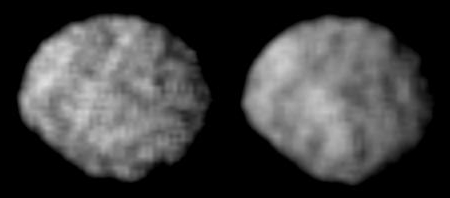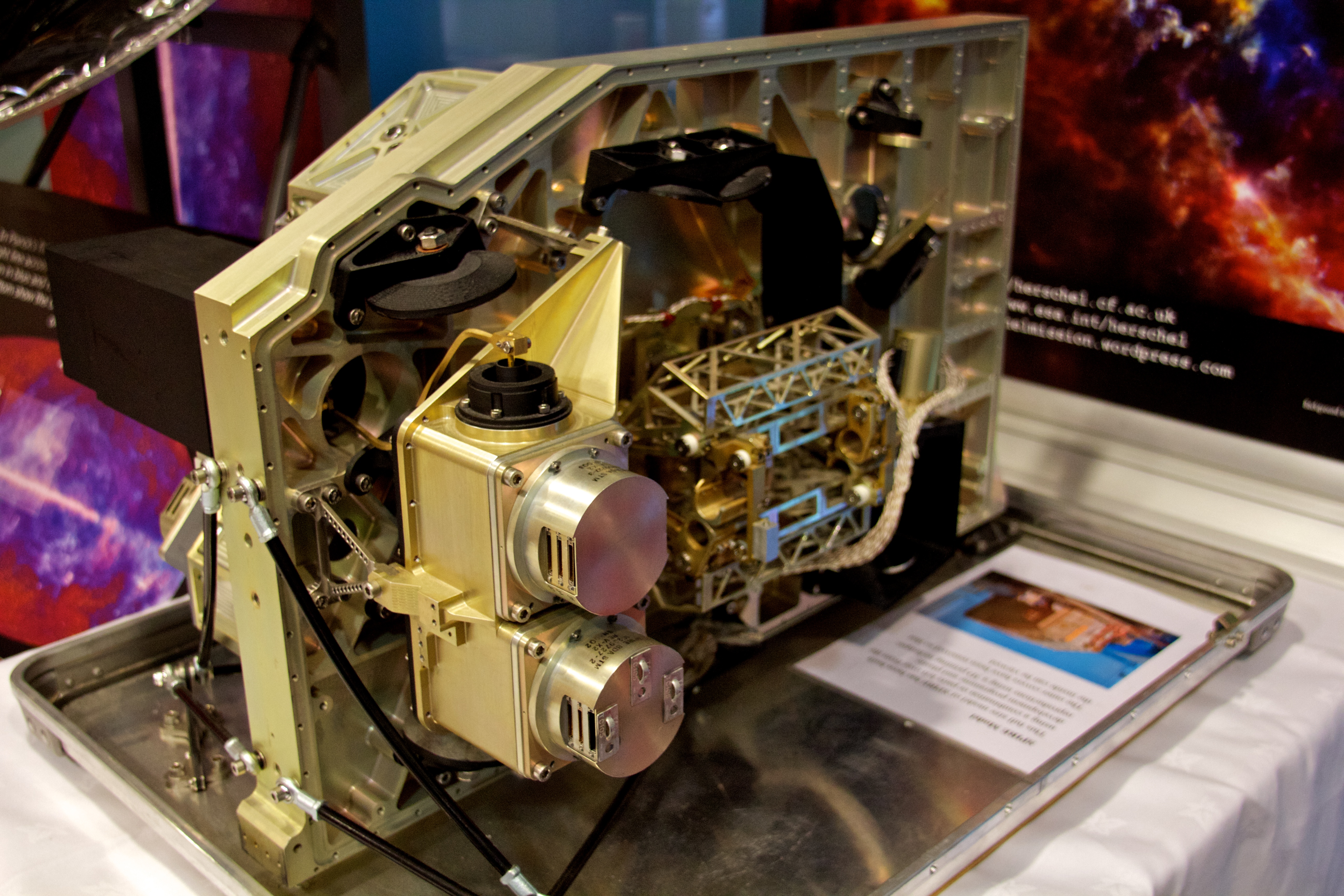|
Nereid (moon)
Nereid, or Neptune II, is the third-largest moon of Neptune. It has the most eccentric orbit of all known moons in the Solar System. It was the second moon of Neptune to be discovered, by Gerard Kuiper in 1949. Discovery and naming Nereid was discovered on 1 May 1949 by Gerard P. Kuiper on photographic plates taken with the 82-inch telescope at the McDonald Observatory. He proposed the name in the report of his discovery. It is named after the Nereids, sea-nymphs of Greek mythology and attendants of the god Neptune. It was the second and last moon of Neptune to be discovered before the arrival of ''Voyager 2'' (not counting a single observation of an occultation by Larissa in 1981). Physical characteristics Nereid is third-largest of Neptune's satellites, and has a mean radius of about . It is rather large for an irregular satellite. The shape of Nereid is unknown. Nereid is around half the size and mass of Saturn's moon Mimas, though Nereid is slightly denser. Since 1987 s ... [...More Info...] [...Related Items...] OR: [Wikipedia] [Google] [Baidu] |
Voyager 2
''Voyager 2'' is a space probe launched by NASA on August 20, 1977, to study the outer planets and interstellar space beyond the Sun's heliosphere. As a part of the Voyager program, it was launched 16 days before its twin, ''Voyager 1'', on a trajectory that took longer to reach gas giants Jupiter and Saturn but enabled further encounters with ice giants Uranus and Neptune. ''Voyager 2'' remains the only spacecraft to have visited either of the ice giant planets. ''Voyager 2'' was the fourth of five spacecraft to achieve Solar escape velocity, which allowed it to leave the Solar System. ''Voyager 2'' successfully fulfilled its primary mission of visiting the Jovian system in 1979, the Saturnian system in 1981, Uranian system in 1986, and the Neptunian system in 1989. The spacecraft is now in its extended mission of studying interstellar space. It has been operating for as of ; , it has reached a distance of from Earth. The probe entered interstellar space on November 5, 2 ... [...More Info...] [...Related Items...] OR: [Wikipedia] [Google] [Baidu] |
Larissa (moon)
Larissa, also known as Neptune VII, is the fifth-closest inner satellite of Neptune. It is named after Larissa, a lover of Poseidon (Neptune) in Greek mythology and eponymous nymph of the city in Thessaly, Greece. Discovery It was first discovered by Harold J. Reitsema, William B. Hubbard, Larry A. Lebofsky and David J. Tholen, based on fortuitous ground-based stellar occultation observations on May 24, 1981, given the temporary designation S/1981 N 1 and announced on May 29, 1981. The moon was recovered and confirmed to be the only object in its orbit during the ''Voyager 2'' flyby in 1989 after which it received the additional designation S/1989 N 2 on August 2, 1989. The announcement by Stephen P. Synnott spoke of “10 frames taken over 5 days”, which gives a recovery date sometime before July 28. The name was given on September 16, 1991. Characteristics The fourth-largest satellite of Neptune, Larissa is irregular (non-spherical) in shape ... [...More Info...] [...Related Items...] OR: [Wikipedia] [Google] [Baidu] |
Minor Planet
According to the International Astronomical Union (IAU), a minor planet is an astronomical object in direct orbit around the Sun that is exclusively classified as neither a planet nor a comet. Before 2006, the IAU officially used the term ''minor planet'', but that year's meeting reclassified minor planets and comets into dwarf planets and small Solar System bodies (SSSBs).Press release, IAU 2006 General Assembly: Result of the IAU Resolution votes International Astronomical Union, August 24, 2006. Accessed May 5, 2008. Minor planets include asteroids ( |
Umbriel (moon)
Umbriel is a moon of Uranus discovered on October 24, 1851, by William Lassell. It was discovered at the same time as Ariel and named after a character in Alexander Pope's 1712 poem ''The Rape of the Lock''. Umbriel consists mainly of ice with a substantial fraction of rock, and may be differentiated into a rocky core and an icy mantle. The surface is the darkest among Uranian moons, and appears to have been shaped primarily by impacts. However, the presence of canyons suggests early endogenic processes, and the moon may have undergone an early endogenically driven resurfacing event that obliterated its older surface. Covered by numerous impact craters reaching in diameter, Umbriel is the second most heavily cratered satellite of Uranus after Oberon. The most prominent surface feature is a ring of bright material on the floor of Wunda crater. This moon, like all moons of Uranus, probably formed from an accretion disk that surrounded the planet just after its formation. The ... [...More Info...] [...Related Items...] OR: [Wikipedia] [Google] [Baidu] |
Titania (moon)
Titania (), also designated Uranus III, is the largest of the moons of Uranus and the List of natural satellites by diameter, eighth largest moon in the Solar System at a diameter of . Discovered by William Herschel in 1787, it is named after the Titania (A Midsummer Night's Dream), queen of the fairies in Shakespeare's ''A Midsummer Night's Dream''. Its orbit lies inside Uranus's magnetosphere. Titania consists of approximately equal amounts of ice and rock (geology), rock, and is probably differentiated into a rocky core (geology), core and an icy mantle (geology), mantle. A layer of liquid water may be present at the core–mantle boundary. Its surface, which is relatively dark and slightly red in color, appears to have been shaped by both impacts and endogenic processes. It is covered with numerous impact craters reaching up to in diameter, but is less heavily cratered than Oberon (moon), Oberon, outermost of the five large moons of Uranus. It may have undergone an early end ... [...More Info...] [...Related Items...] OR: [Wikipedia] [Google] [Baidu] |
Uranus
Uranus is the seventh planet from the Sun. Its name is a reference to the Greek god of the sky, Uranus (mythology), Uranus (Caelus), who, according to Greek mythology, was the great-grandfather of Ares (Mars (mythology), Mars), grandfather of Zeus (Jupiter (mythology), Jupiter) and father of Cronus (Saturn (mythology), Saturn). It has the third-largest planetary radius and fourth-largest planetary mass in the Solar System. Uranus is similar in composition to Neptune, and both have bulk chemical compositions which differ from that of the larger gas giants Jupiter and Saturn. For this reason, scientists often classify Uranus and Neptune as "ice giants" to distinguish them from the other giant planets. As with gas giants, ice giants also lack a well defined "solid surface." Uranus's Atmosphere#Others, atmosphere is similar to Jupiter's and Saturn's in its primary composition of hydrogen and helium, but it contains more "volatiles, ices" such as water, ammonia, and methane, al ... [...More Info...] [...Related Items...] OR: [Wikipedia] [Google] [Baidu] |
Electromagnetic Spectrum
The electromagnetic spectrum is the range of frequencies (the spectrum) of electromagnetic radiation and their respective wavelengths and photon energies. The electromagnetic spectrum covers electromagnetic waves with frequencies ranging from below one hertz to above 1025 hertz, corresponding to wavelengths from thousands of kilometers down to a fraction of the size of an atomic nucleus. This frequency range is divided into separate bands, and the electromagnetic waves within each frequency band are called by different names; beginning at the low frequency (long wavelength) end of the spectrum these are: radio waves, microwaves, infrared, visible light, ultraviolet, X-rays, and gamma rays at the high-frequency (short wavelength) end. The electromagnetic waves in each of these bands have different characteristics, such as how they are produced, how they interact with matter, and their practical applications. There is no known limit for long and short wavelengths. Extreme ultr ... [...More Info...] [...Related Items...] OR: [Wikipedia] [Google] [Baidu] |
Herschel Space Observatory
The Herschel Space Observatory was a space observatory built and operated by the European Space Agency (ESA). It was active from 2009 to 2013, and was the largest infrared telescope ever launched until the launch of the James Webb Space Telescope in 2021. Herschel carries a mirror and instruments sensitive to the far infrared and submillimetre wavebands (55–672 µm). Herschel was the fourth and final cornerstone mission in the Horizon 2000 programme, following ''SOHO''/'' Cluster II'', ''XMM-Newton'' and ''Rosetta''. The observatory was carried into orbit by an Ariane 5 in May 2009, reaching the second Lagrangian point (L2) of the Earth–Sun system, from Earth, about two months later. Herschel is named after Sir William Herschel, the discoverer of the infrared spectrum and planet Uranus, and his sister and collaborator Caroline Herschel. The observatory was capable of seeing the coldest and dustiest objects in space; for example, cool cocoons where stars form and ... [...More Info...] [...Related Items...] OR: [Wikipedia] [Google] [Baidu] |
Spitzer Space Telescope
The Spitzer Space Telescope, formerly the Space Infrared Telescope Facility (SIRTF), was an infrared space telescope launched in 2003. Operations ended on 30 January 2020. Spitzer was the third space telescope dedicated to infrared astronomy, following IRAS (1983) and ISO (1995–1998). It was the first spacecraft to use an Earth-trailing orbit, later used by the Kepler planet-finder. The planned mission period was to be 2.5 years with a pre-launch expectation that the mission could extend to five or slightly more years until the onboard liquid helium supply was exhausted. This occurred on 15 May 2009. Without liquid helium to cool the telescope to the very low temperatures needed to operate, most of the instruments were no longer usable. However, the two shortest-wavelength modules of the IRAC camera continued to operate with the same sensitivity as before the helium was exhausted, and continued to be used into early 2020 in the Spitzer Warm Mission. During the warm mission, t ... [...More Info...] [...Related Items...] OR: [Wikipedia] [Google] [Baidu] |
Hyperion (moon)
Hyperion , also known as Saturn VII, is a moon of Saturn discovered by William Cranch Bond, his son George Phillips Bond and William Lassell in 1848. It is distinguished by its irregular shape, its chaotic rotation, and its unexplained sponge-like appearance. It was the first non-round moon to be discovered. Name The moon is named after Hyperion, the Titan god of watchfulness and observation – the elder brother of Cronus, the Greek equivalent of the Roman god Saturn. It is also designated ''Saturn VII''. The adjectival form of the name is ''Hyperionian''. Hyperion's discovery came shortly after John Herschel had suggested names for the seven previously known satellites of Saturn in his 1847 publication ''Results of Astronomical Observations made at the Cape of Good Hope''. William Lassell, who saw Hyperion two days after William Bond, had already endorsed Herschel's naming scheme and suggested the name Hyperion in accordance with it. He also beat Bond to pu ... [...More Info...] [...Related Items...] OR: [Wikipedia] [Google] [Baidu] |
Precession
Precession is a change in the orientation of the rotational axis of a rotating body. In an appropriate reference frame it can be defined as a change in the first Euler angle, whereas the third Euler angle defines the rotation itself. In other words, if the axis of rotation of a body is itself rotating about a second axis, that body is said to be precessing about the second axis. A motion in which the second Euler angle changes is called ''nutation''. In physics, there are two types of precession: torque-free and torque-induced. In astronomy, ''precession'' refers to any of several slow changes in an astronomical body's rotational or orbital parameters. An important example is the steady change in the orientation of the axis of rotation of the Earth, known as the precession of the equinoxes. Torque-free Torque-free precession implies that no external moment (torque) is applied to the body. In torque-free precession, the angular momentum is a constant, but the angular velocit ... [...More Info...] [...Related Items...] OR: [Wikipedia] [Google] [Baidu] |








